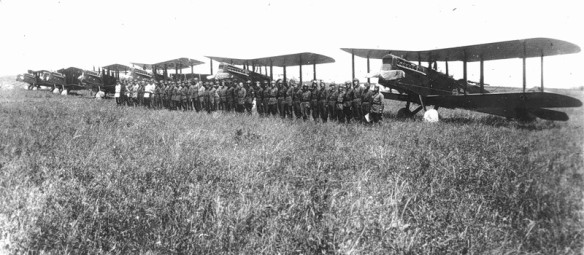Soviet 68th Separate Naval Aircraft Squad in 1929 – MR-1 type aircraft.
Universal (river and sea) gunboat of “Storm” type, designed and built in 1911, re-armed in 1920 with captured English 120-mm. cannons.
Press photo released from 1929 mentioning the clash and showing Soviet troops.
The Far Eastern crisis of 1929 had its origins in the arrangements which the Soviet Government, following in the footsteps of the Imperial Russian Government, had made with the Chinese over the ownership and rights of operation of the Chinese Eastern Railroad, which linked the Trans-Siberian line with Vladivostok across Manchuria. The Chinese had frequently objected to Soviet rights over this railway, but the rising power of the Nationalist Government in China under General Chiang Kai-shek and Chiang’s thorough defeat of his Communist allies in 1927 led him to believe that he could bring military pressure to bear on the Soviet Union itself. In 1928-1929 Chiang’s authority did not extent to Manchuria, which was ruled by the provincial warlord Chang Hsueh-liang, but the success of the Nationalists in south and central China brought about a meeting between the two leaders in which they plotted joint action against the Soviet concessions in Chang Hsueg-liang’s province. For once, the interests of the Soviet Government and the Japanese temporarily coincided, for the Japanese, who intended to occupy Manchuria themselves, had no objection to Soviet military action to weaken the provincial Manchurian Army, which was concentrated on the Soviet border by the summer of 1929, and threatened the security of the Soviet-operated railway.
Reasonably assured, therefore, that the Japanese would not intervene against the Red Army, the Soviet leaders prepared their forces for operations in Manchuria in July-August 1929. On August 7 the Revolutionary Military Council established the Special Far Eastern Army in the eastern part of the Siberian Military District, with its headquarters in Khabarovsk. Blukher, who had returned from China in 1927, was placed in command, and two new rifle corps were formed, the 18th in the Transbaikal sector and the 19th in the Maritime Territory. The new army had a strength of six rifle divisions and two cavalry brigades, which were still forming up when the Manchurian forces began to raid Soviet territory and installations. The Red Army, however, waited until the autumn before launching its counterattacks.
There were 3 separate operations – Sungari operation (subdivided by 2 stages – Laha-Susu operation and Fujing operation), Zhalainoer operation and Mishan operation.
There were Amur river flotilla and 2 rifle regiments of the 2-nd Priamurskaya rifle division of Special Far East Army – 6th Khabarovsky and 4th Volochaevsky regiments with a lot of avircrafts (com[aring to Chinese forces). They were prepared to land near the Laha-Susu in the mouth of Sungari River but at first aircrafts bombed Chinese men-of-war located in vicinity of Laha-Susuunder the flag of Admiral Shen Lie. Some of them were sunk, some of them fled, several gunboats (originally Russian paddy-wheel steamers captured by Chinese after 1917) tried to resist but were sunk by Soviet gunboats after a duelling. Then the Soviet soldiers were landed under ramparts of Laha-Susu and after the bombardment of the forts from Soviet gunboats assaulted it. In the evening all Soviet troops were evacuated and did not stay in China even for a night.
Remnants of Sungari flotilla of Shen Lie gathered in Fujing (or Fugdin in Nanai languages as this fort was built by Qing authorities in 1880th to engage Nanai tribesmen into the Eight Banner system) and by the 29th of October it became obvious that the second blow to destroy Sungari flotilla is necessary. So Red Army troops were regrouped and 6th Khabarovsky rifle regiment was substituted by 5th Amursky rifle regiment. After strong bombing Chinese men-of-war were sunk and soldiers destroyed most part of Chinese fortifications in Fugdin. In that time Soviet troops stayed in China for couple of days and then were evacuated. A larger operation was mounted by the 18th Corps at the junction of the Soviet, Chinese and outer Mongolian frontlines, where a concentration of Chang Hsueh-liang’s troops threatened the railway at Manchouli. Here three Soviet divisions and a cavalry brigade crossed the frontier on November 17, cut the railway between Dalainor and Hailar, and surrounded the Manchurian forces in the area. Heavy fighting to destroy the encircled enemy followed, in which cooperation among the Soviet infantry, tanks, and artillery broke down, resulting in heavy casualties. Some of the Manchurian units succeeded in breaking out of the encirclement, but the majority capitulated, and by November 27 the operations were over. Simultaneously, troops of the 19th Corps broke up a Manchurian concentration at Mishan, near Lake Khanka, 100 miles north of Vladivostok, although the Red Army, largely out of willingness to antagonize the Japanese, did not pursue their opponents beyond the confines of the immediate zone of operations.
According to “Soviet Casualties and Combat Losses in the Twentieth Century”, the USSR sustained losses of 143 KIA, 4 MIA, and 665 WIA during the course of these operations. The book states that around 18,000 troops were engaged.
